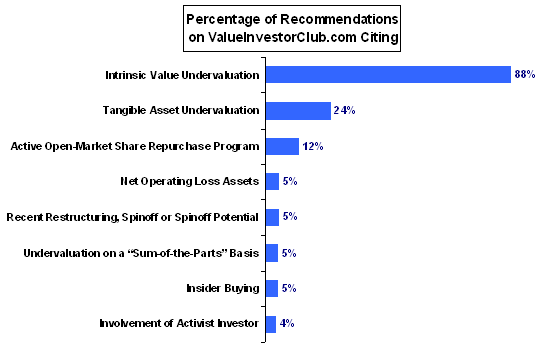How do professional value investors make investment decisions? Do they beat the market? In their January 2009 preliminary paper entitled “Fundamental Value Investors: Characteristics and Performance”, Wesley Gray and Andrew Kern examine the detailed investment decision process and aggregate performance of professional value investors who participate in ValueInvestorsClub.com, an “exclusive [and confidential] online investment club where top investors share their best ideas.” The founders of ValueInvestorsClub.com are Joel Greenblatt and John Petry of Gotham Capital. Using a sample of 2,912 investment recommendations by ValueInvestorsClub.com members during January 2000 through June 2008, along with associated firm fundamentals and stock return data, they conclude that:
- Value investors generally employ no more than three criteria when making investment decisions, with only 2% citing four or more criteria.
- While value investors exploit traditional tangible asset undervaluation (such as high book-to-market ratio), they assign much more importance to discovery of intrinsic undervaluation (based on factors such as discounted cash flow analysis and earnings multiples). They also sometimes consider open market repurchases and other indications of hidden value. (See the chart below.) None of the recommendations use statistical asset pricing models from the academic literature.
- Most recommendations (87%) are for long positions concentrated in small companies with a slight value tilt. Recommendations for short positions are concentrated in small growth companies. The most widely represented sector is manufacturing.
- 554 long and 56 short recommendations have aged enough for multi-year return measurement. Abnormal returns for long positions are economically and statistically significant for one-year holding periods but decline beyond one year. Short positions generate strong abnormal returns over horizons of one, two and three years.
The following chart, constructed from data in the paper, summarizes the frequency with which the 2,912 investment recommendations by ValueInvestorsClub.com members during January 2000 through June 2008 cite the specific listed reasons for investing.

In summary, the professional investors at ValueInvestorsClub.com on average successfully identify and exploit value opportunities by focusing mostly on mismatches between stock price and intrinsic value.